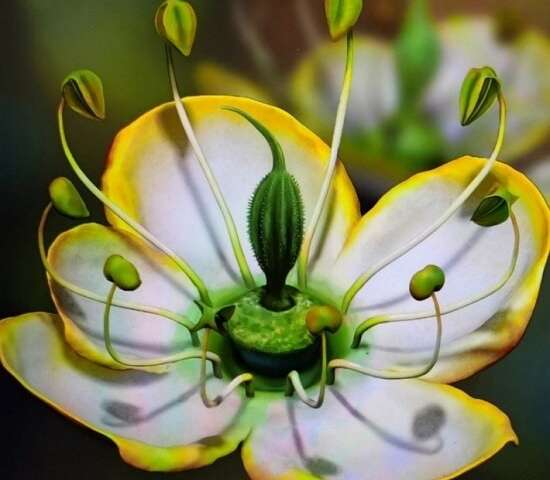
The evolution of flowers is among the foremost topics in evolutionary science. There is a long-held hypothesis in botany that a flower is a telescoped shoot. It has been cherished by many botanists and supported by various studies of living flowers, but there is no related fossil evidence proving or rejecting this hypothesis.
Dr. Wang Xin from the Nanjing Institute of Geology and Paleontology of the Chinese Academy of Sciences (NIGPAS) and collaborators from Fujian Agriculture and Forestry University, University of Vigo, and Fushun Amber Institute have reported that a flower Dinganthus pentamera embedded in a 15- to 20-million-year-old Dominican amber sheds new light on the evolution of flowers. The study was published in Palaeoentomology.
The flower, Dinganthus, was dedicated to the former president of Peking University and leading mathematician, Dr. Ding Shisun (1927-2019). The specimen is deposited in the Fushun Amber Institute.
Dinganthus is small, only 3-4 millimeters in dimensions. It is three dimensionally preserved in a piece of amber uncovered from the Miocene stratum. The good preservation and modern observation technology (Micro-CT) allow the key features of the flower to be clearly demonstrated.
The flower includes bracts, tepals, stamens, and gynoecium. And this flower has five petals with recurved fringes and 10 curving stamens surrounding a gynoecium with a curved style in the center. Each stamen is filamentous, with a tetrasporangiate anther on the top. This flower belongs to the largest group in angiosperms, the Eudicots.
Although the history of Eudicots has been pushed back to the mid-Cretaceous (about 100 million years ago) by another flower in amber Lijinganthus, there is no meaningful fossil evidence suggesting how the flowers evolved.
Different from the typical eudicot flowers, which usually have their calyx, corolla, stamens and gynoecium crowded onto the same point of flower axis (receptacle), Dinganthus have these organs spatially distanced along the flower axis, as if these parts were arranged along an axis.
Despite its young age, the unique morphology of Dinganthus, using fossil evidence for the first time, tells botanists: a flower could be a condensed shoot, a long-held idea in the past centuries.
This new evidence will help botanists to decipher the essence of flowers, and help palaeobotanists to understand bizarre-appearing flowers such as Archaefructus and Yuhania.
A unique flower in Miocene amber sheds new light on the evolution of flowers
, Palaeoentomology (2020). DOI: 10.11646/palaeoentomology.3.4.15Citation: Dinganthus sheds new light on evolution of flowers (2020, September 14) retrieved 14 September 2020 from https://phys.org/news/2020-09-dinganthus-evolution.html
This document is subject to copyright. Apart from any fair dealing for the purpose of private study or research, no part may be reproduced without the written permission. The content is provided for information purposes only.
September 14, 2020 at 08:21PM
https://phys.org/news/2020-09-dinganthus-evolution.html
Dinganthus sheds new light on evolution of flowers - Phys.org
https://news.google.com/search?q=Flower&hl=en-US&gl=US&ceid=US:en

No comments:
Post a Comment